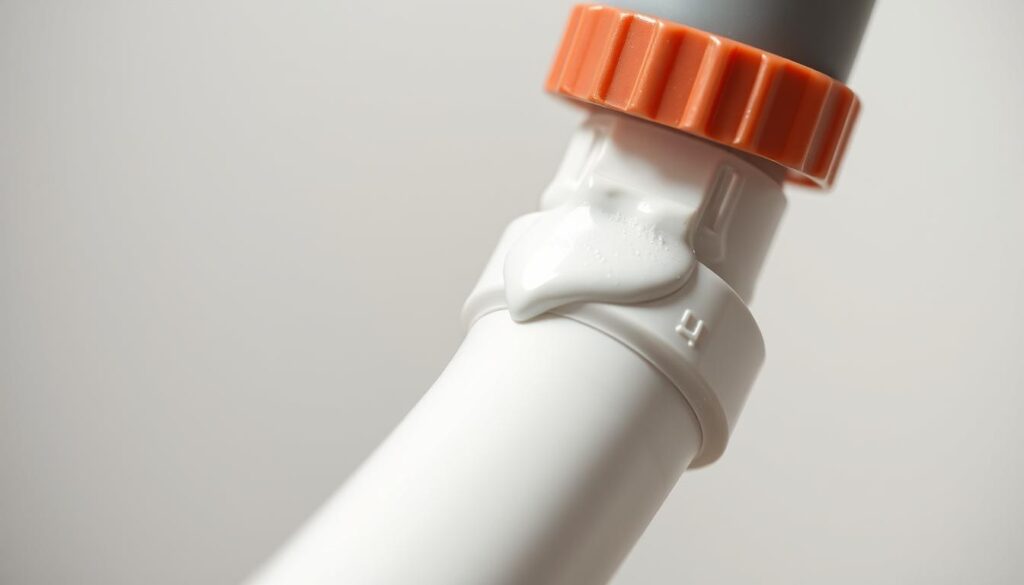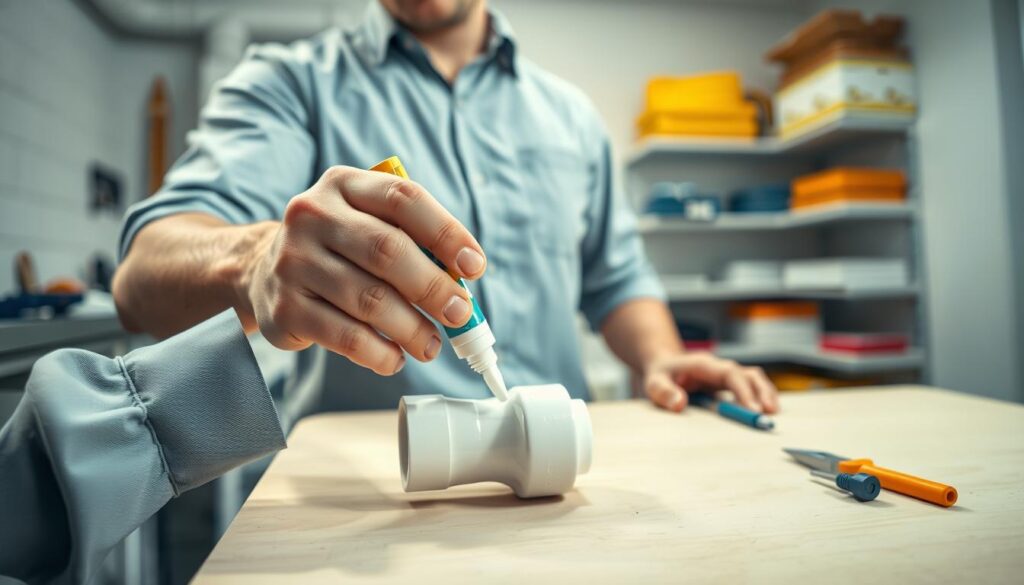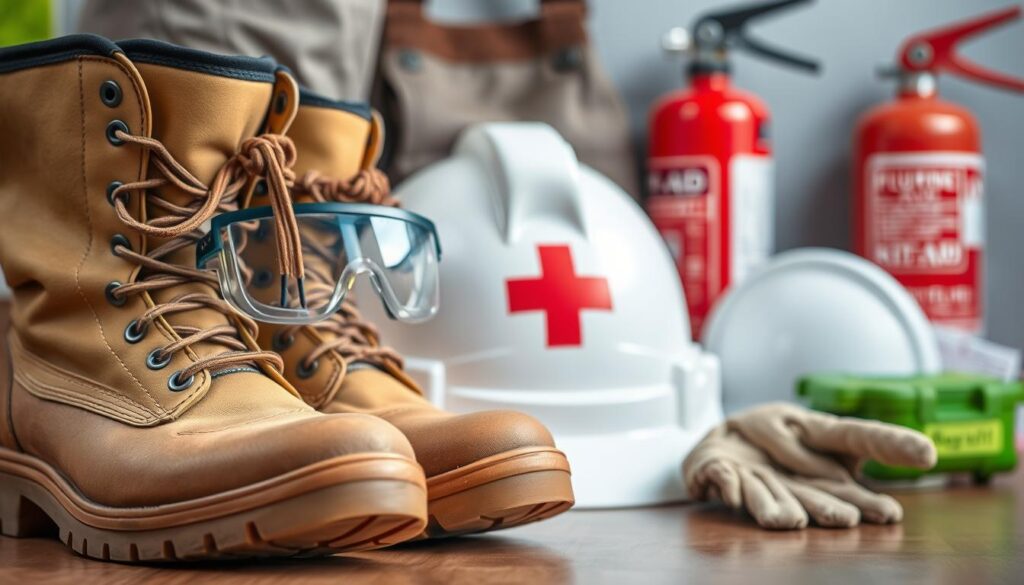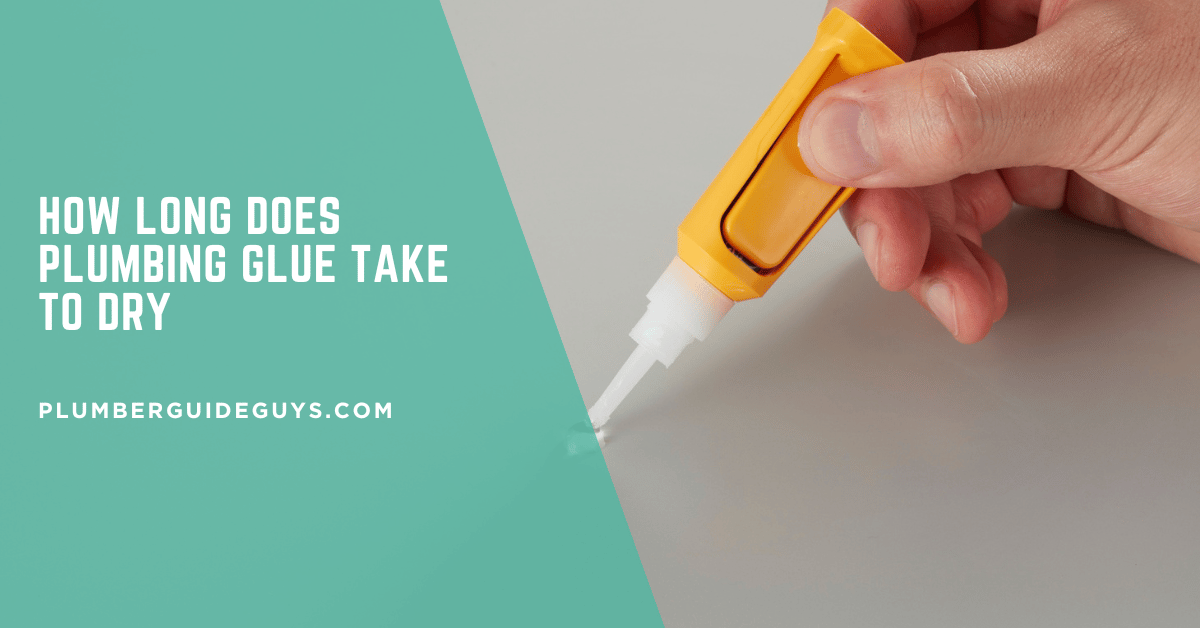Affiliate Disclosure
Plumber Guide Guys is a participant in the Amazon Services LLC Associates Program, an affiliate advertising program designed to provide a means for sites to earn advertising fees by advertising and linking to Amazon.
How Long Does Plumbing Glue Take to Dry? Did you know that nearly 85% of plumbing failures are caused by bad pipe connections? Knowing how long plumbing glue takes to dry is key for leak-free connections. When doing DIY plumbing, knowing the exact PVC cement drying time is vital.

When fixing plumbing, the drying time for PVC cement is not simple. Professional plumbers say it depends on several factors. It usually takes 15 to 30 minutes for the initial set. But, it takes about 2 hours to reach full strength.
PVC cement is not just glue. It’s a solvent-based chemical that melts and fuses pipes. This process creates a strong, lasting connection. Knowing about drying times can make your plumbing projects better and last longer.
Key Takeaways
- PVC cement requires 15-30 minutes for initial set
- Full pipe connection strength takes about 2 hours
- Temperature and humidity impact drying time
- Proper application is critical for strong connections
- Different pipe sizes affect overall curing process
Table of Contents
Understanding PVC Solvent Cement and Its Properties
Working with plumbing systems means knowing about PVC solvent cement. It’s not just an adhesive; it creates a strong bond. This bond is not just about sticking things together. It’s about a molecular fusion.
PVC solvent cement works through a chemical process. It softens the pipe and fitting surfaces. This lets them partially dissolve and mix together.
This creates a strong, permanent connection. It’s different from mechanical attachments.
The Chemical Composition of PVC Cement
The main parts of PVC cement are:
- Tetrahydrofuran (THF) solvent
- Cyclohexanone
- Specialized resins
- Stabilizing compounds
Why It’s Not Actually a Glue
When people talk about pvc pipe glue dry time, they’re not always right. Solvent cement doesn’t act like regular glue. It chemically welds the pipe materials together.
This makes a seamless, pressure-resistant connection.
Different Types of Plumbing Adhesives
| Cement Type | Best Used For | Curing Speed |
|---|---|---|
| Regular PVC Cement | Standard residential plumbing | 15-30 minutes |
| Fast-Setting Cement | Emergency repairs | 5-10 minutes |
| Heavy-Duty Cement | Industrial applications | 45-60 minutes |
Each cement type has special properties for different plumbing needs. This means you can find the right one for your project.
How Long Does Plumbing Glue Take to Dry
Knowing how long plumbing glue takes to dry is key for a leak-free pipe connection. When you’re working on a plumbing project, understanding this can save you time. It also helps avoid installation mistakes.
Plumbing joint curing has two important stages: initial set time and full cure time. These stages are different, and knowing them is essential for proper pipe installation.
Initial Set Time vs Full Cure Time
The initial set time for plumbing glue is surprisingly quick. Depending on conditions, you might see:
- Small pipes: As fast as 2-5 minutes
- Larger pipes: Up to 15-30 minutes
- Temperature and humidity impact set times
The full cure time, which is critical for structural integrity, takes much longer. You should wait 2-24 hours before putting pipes under full pressure. This depends on pipe size and environmental conditions.
Standard Drying Time Guidelines
Professional plumbers suggest following manufacturer-specific guidelines. A detailed resource on solvent cement curing times offers insights into various pipe sizes and temperatures.
“Patience during the curing process ensures a strong, leak-free connection.” – Plumbing Professional
Pressure Testing Requirements
Before doing pressure tests, make sure your plumbing joints are fully cured. Testing too soon can weaken your pipe connections. This might cause them to fail.
- Wait the recommended cure time
- Check the manufacturer’s specific guidelines
- Consider ambient temperature and pipe size
Essential Factors Affecting Drying Time
Working with pipe cement requires knowing what affects drying time. The conditions for drying pipe cement can change a lot. This is because of several important factors that directly affect how long it takes for the cement to dry.
The main things that affect how fast cement dries include:
- Environmental Temperature: Warmer temperatures help the cement bond faster. Cold temperatures make it dry slower.
- Humidity Levels: Too much moisture can slow down how well the cement sticks. It also makes it dry longer.
- Pipe Material: Different pipes react differently with the cement. This affects how well it dries.
- Cement Quality: Better solvent cements dry more consistently. They are made to work better under different conditions.
The drying conditions for your pipe cement depend on these factors. Plumbers say it’s important to watch these closely. This ensures strong and lasting pipe connections.
Experts use special ways to handle these conditions. They do things like:
- Checking the temperature before they start
- Making sure the pipes are clean and dry
- Choosing the right cement for the pipe material
- Keeping the area well-ventilated while it dries
By knowing and controlling these key factors, you can make your plumbing cement work better. This makes your plumbing projects more reliable and effective.
Temperature and Humidity Impact on Curing Process
Working with plumbing adhesive means knowing how temperature and humidity affect it. These factors are key to a successful installation. The right conditions are essential for your plumbing adhesive to set properly.
Your plumbing project’s success depends on the right conditions for bonding. Different environmental factors can greatly affect how quickly and well your PVC cement cures.
Optimal Temperature Ranges
The best temperature for applying PVC cement is between 40°F and 110°F. If your project is outside this range, it can slow down the adhesive’s setting:
- Temperatures below 40°F slow down chemical reactions
- Temperatures above 110°F can cause rapid solvent evaporation
- Moderate temperatures between 60°F and 85°F provide optimal curing conditions
Humidity Level Considerations
Humidity greatly affects how long it takes for PVC pipe glue to dry. High moisture levels can slow down solvent evaporation, weakening pipe connections:
- Ideal humidity ranges between 40% and 60%
- Extremely humid environments extend drying times
- Low humidity can accelerate solvent evaporation
Working in Different Weather Conditions
Professional plumbers adjust their methods based on the weather. Always check manufacturer recommendations for specific guidance on your plumbing adhesive set time. In tough weather, consider:
- Using climate-controlled work areas
- Selecting specialized adhesives for extreme conditions
- Allowing extra curing time in challenging weather
Pipe Size and Its Effect on Drying Duration
Knowing how pipe size affects curing time is key for pipe installation success. Different sizes need different drying times for PVC cement. This can greatly change your project’s schedule.
Working with plumbing, bigger pipes need more care during curing. The amount of PVC cement and the surface area affect drying time for each joint.
- Small pipes (½ to 1 inch): Typically quickest to cure
- Medium pipes (1.5 to 3 inches): Moderate curing time
- Large pipes (4 inches and above): Longest curing duration
Every plumbing project needs careful thought about pipe size. Larger pipes require more cement and have more surface tension. So, they need more time for bonding.
| Pipe Size | Recommended Cure Time | Joint Strength Development |
|---|---|---|
| ½ inch | 15-20 minutes | Rapid initial set |
| 2 inches | 30-45 minutes | Moderate strength build |
| 6 inches | 60-90 minutes | Slow, complete curing |
Experts say to always follow the manufacturer’s guidelines for drying times. This ensures your plumbing system is strong and leak-free.
Proper Application Techniques for Optimal Results
To get the best results with pipe cement, you need to prepare well and apply it correctly. Knowing how long it takes to dry starts with using the right methods. These methods help make a strong, lasting bond.

Surface Preparation Steps
Getting your surfaces ready is key for good pipe cementing. Here’s what to do:
- Clean the pipe and fitting surfaces well with a clean cloth
- Make sure to remove all dirt, grease, and moisture
- Use PVC primer to make the surface ready
- Make sure the surfaces are dry before you apply cement
Correct Application Methods
When you apply plumbing glue, you need to be precise. Here’s how to do it right:
- Put a thin, even layer of cement around the pipe’s end
- Put the pipe into the fitting with a quarter-turn rotation
- Hold the pipes together for 15-30 seconds
- Let the connection set for the time recommended
| Pipe Diameter | Recommended Hold Time | Full Cure Time |
|---|---|---|
| 1/2 inch | 15-20 seconds | 2 hours |
| 1 inch | 20-30 seconds | 4 hours |
| 2 inches | 30-45 seconds | 6-8 hours |
Common Application Mistakes to Avoid
Stay away from these common mistakes to avoid drying issues:
- Skipping primer which weakens the bond
- Using too much or too little cement
- Not cleaning surfaces before applying
- Rushing the assembly
- Applying cement in extreme temperatures
By following these steps, you’ll make strong, reliable pipe connections. These connections dry well and last a long time.
Quality and Type of Cement Considerations
Choosing the right plumbing adhesive is key for strong, lasting pipe connections. The quality of your PVC pipe glue dry time affects your plumbing project’s strength. Not all cements are the same, and knowing the differences can save you time and money.
When picking a plumbing adhesive, think about these important factors:
- Chemical composition of the solvent cement
- Intended application environment
- Specific pipe material compatibility
- Temperature and humidity resistance
High-quality PVC cements have many benefits for your plumbing project. Professional-grade products usually offer:
- Faster initial bonding
- Enhanced structural strength
- Better resistance to temperature changes
- Longer-lasting pipe connections
Different cements are for different needs. Regular cement is best for home projects, while heavy-duty options are for tough environments. Special cements can cut down on dry time and make connections more reliable.
Professional plumbers say to invest in top-notch cement from trusted makers for the best pipe connections.
Your cement choice should fit your project needs. Always check the manufacturer’s specs and pick products made for your plumbing job for the best results.
Safety Measures During the Drying Process
Working with plumbing joint cement needs careful safety steps. The time it takes for the joint to cure involves important safety tips. These tips keep you and your work area safe.

Ventilation Requirements
Good ventilation is key when using pipe cement. The fumes from PVC cement can be dangerous if breathed in too much. Make sure to:
- Work in open or well-ventilated areas
- Use fans to circulate air
- Avoid enclosed spaces during application
- Keep windows and doors open during the curing process
Personal Protection Equipment
Protecting yourself is vital during the curing process. Always wear:
- Chemical-resistant gloves
- Safety goggles or face shield
- Long-sleeved clothing
- Respiratory mask with organic vapor cartridges
Emergency Procedures
Even with precautions, accidents can occur. Be ready for emergencies by:
- Keeping water nearby for immediate skin rinse
- Having eye wash station accessible
- Knowing local poison control contact information
- Removing contaminated clothing immediately
Safety isn’t expensive—it’s priceless. Always prioritize protecting yourself when working with plumbing adhesives.
Conclusion
Knowing how long plumbing glue takes to dry is key for good pipe connections. Factors like temperature, humidity, and pipe size affect the strength of your plumbing. Waiting patiently for the pvc cement to dry ensures your connections are leak-free and strong.
Using the right application techniques is important for the best results. Preparing surfaces well, applying cement correctly, and waiting for it to cure fully are essential. This way, you make plumbing connections that can handle pressure and environmental changes. Don’t rush the process, as it can weaken your pipes.
Professional plumbers focus on details for success. When you work on a project, understand what your pvc cement needs. Follow the manufacturer’s instructions, work in a good environment, and always put safety first. Your hard work will lead to strong, reliable plumbing that lasts for years.
Knowledge is your most valuable tool when using plumbing adhesives. By respecting the drying time and applying what you’ve learned, you’ll improve your work quality. This helps you avoid expensive mistakes.

